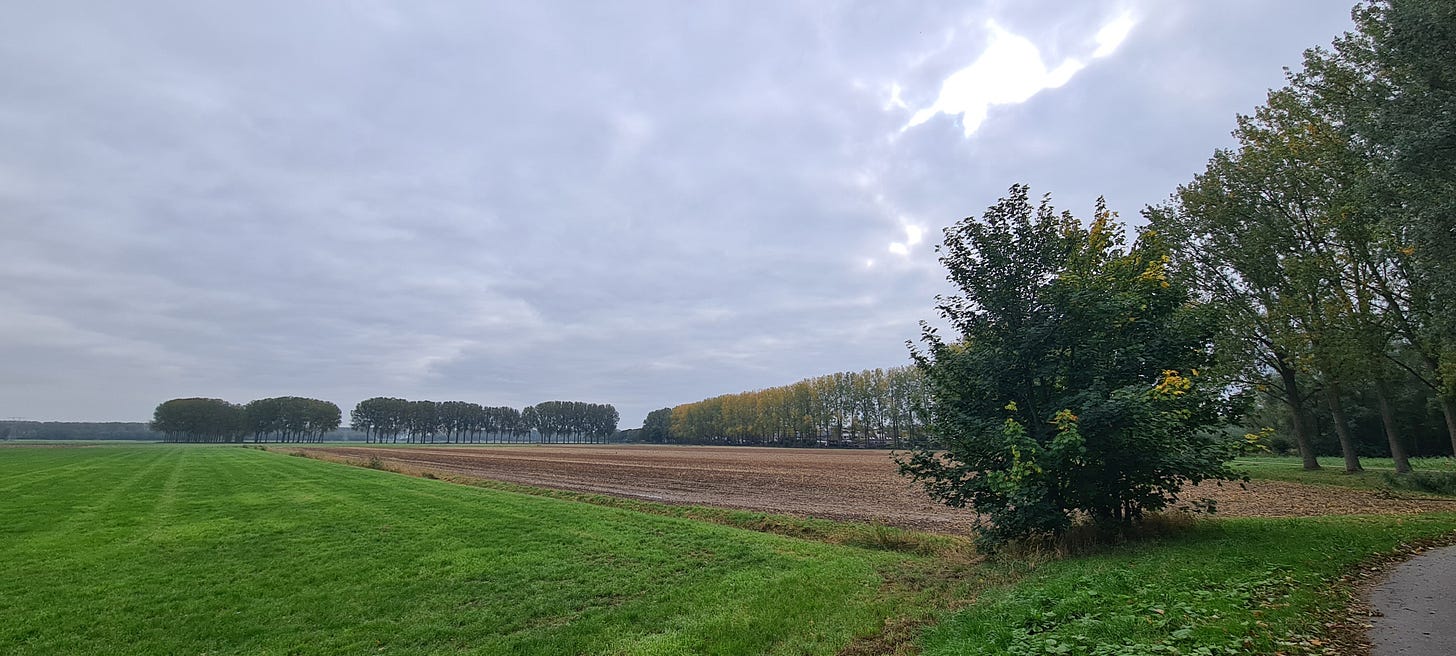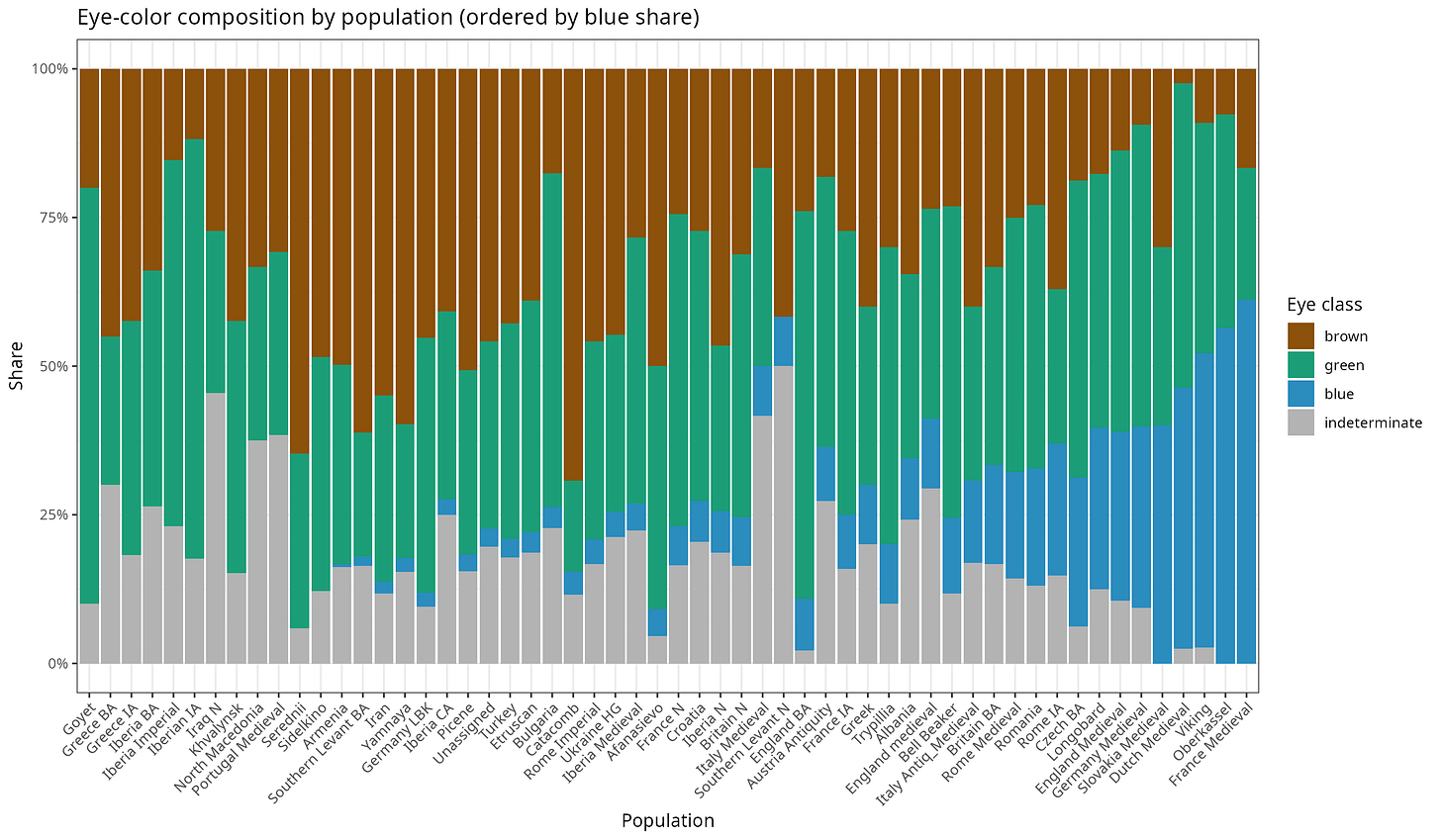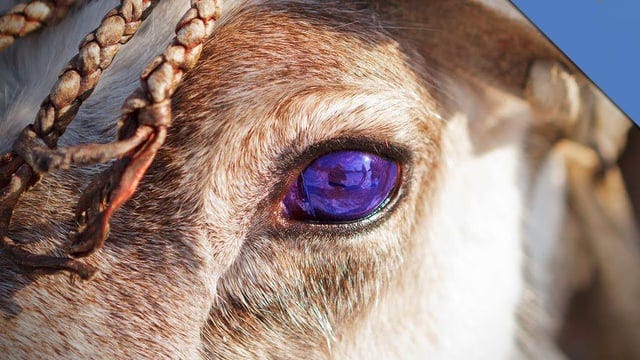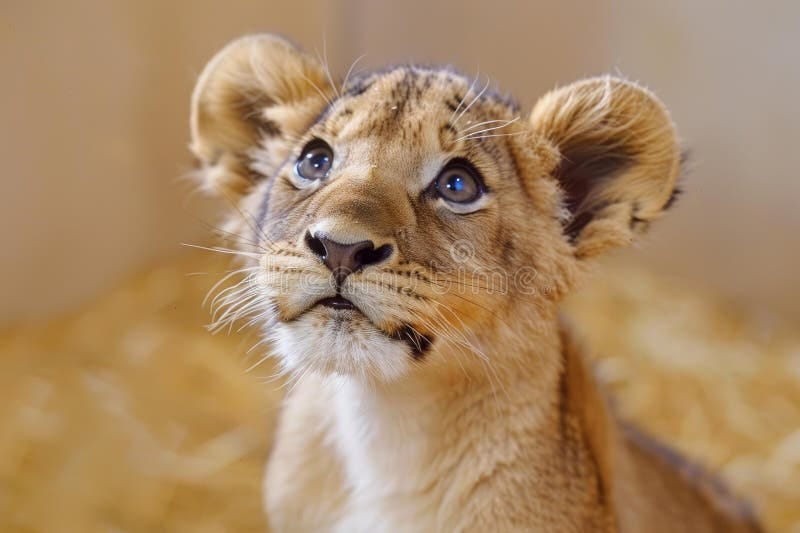Recently, I’ve noticed an uptick in scientific articles claiming that either blue eyes or blond hair are some kind of recent mutation, selected for sexual fashion (i.e., for no purpose, no benefit), as though blond and blue-eyed people were a rarity before the Viking Age.
I believe this research is unscientific and motivated by Afrocentrist or Marxist desires to erase blond/blue-eyed people from European history, as though we were an aberration that “doesn’t even belong in Europe”. I call bullshit and maintain that blue eyes and blond hair must have existed in Nordic European populations (even Neanderthals) long, long ago.
Hypothesis: blue eyes in humans aren’t a fashion-selected useless feature, nor did it become popular in Europe during only the last 500 years.
You may have noticed a spectrum of dark to light eye colors, ranging from people living around the equator (whose eyes are all black) to people living closer to the North Pole (such as the many varied eye colors of Northern Europeans, including green, hazel, gray, and blue).
Logically speaking, this is the first clue that eye color is some kind of climatic adaptation.

Let’s look at other mammals for a moment. Why is it that polar bears generally have black or very dark eyes? And although there are a few people living among the Inuit/Eskimo tribes who have blue eyes, the majority of these Asiatic peoples—just like polar bears—have dark to black eyes. The dark or thick pigment in their eyes protect against glare from the snow.
O.K., so if having dark eyes protects against sunlight, what could light eyes be for? Other mammalian species may provide a hint: Of the five mammalian species whose cubs have blue eyes (snow leopard, cougar, gray wolf, coyote, African lion), ALL FIVE of these species’ young grow up hidden away in dark lairs or buried in burrows.
Hey, wait a minute! It’s as if blue eyes have something to do with low-light conditions.
We observe in polar bears and Inuit people that their eyes are dark to protect against glare. We observe in equatorial populations of Central Africa that their eyes are dark in the tropical sun. And we observe that cubs of certain mammalian species can have blue eyes when they are young, and buried in burrows, until their eye color changes (into darker shades) when they leave the burrows.
So, do people with lighter eyes perhaps see better in the dark? Is it an adaptation to lower light conditions of, say, Northern Europe (fog, rain, clouds, less sunlight, shorter winter days, longer winters season)?
Personal anecdotes say so (my blue-eyed friends are blinded by the midday Sun but can see well in the dark). And this recent research also says so:
Cain, F. E., & Yamaguchi, K. (2024). Effect of iris pigmentation of blue and brown eyed individuals with European ancestry on ability to see in low light conditions after a short-term dark adaption period.
The majority of people with blue eyes are clustered in North-Western Europe, or are descendants of such people. This territory was traditionally (sub-Arctic) FOREST. Much of Europe used to be like Siberia. So you’d have a large environment for low-light conditions during long winters + a ton of shade during the summers + behavioral reasons for people to be outside in the dark?
Clearly, human blue eyes come from such low-light, cold forest conditions. But perhaps not from the steppe pastoralists of Southern Russia. It may be so that the invading “Aryans” didn’t have blue eyes. But there’s a problem: Genetics studies apparently can’t identify large populations of ancient Western Hunter Gatherers, or other Europeans, with blue eyes!
Well, to me, that just means that the geneticists are wrong. The genes nowadays coding for blue eyes may have been totally different genes but with the same phenotype in a distant past. Since we don’t know about these genes, we can’t test for them.
For example, the graph below is supposed to show that blue eyes only became popular during the last 500 years under the influence of freak mutant Vikings. It’s just that the “undetermined” category disappears right when blue eyes appear on the timeline.

“Undetermined”, in my view, just means “also blue” or “another kind of blue”. Overall, I find the science claiming that human blue eyes only became popular after the Viking Age simply bullshit. We would never question that lion cubs had blue eyes before the Viking Age. Why do human blue eyes infect scientists with such fear?
Blue and light eyes (green, hazel, gray, etc.) clearly are adaptations for low-light conditions such as in the hunting forests of North-Western Europe. I argue that even Nordic Neanderthals would have had such adaptions, including the blond hair. Even if the Indo-European invaders didn’t have these features (though they probably also did), the recipient native European population certainly did.
Am I speculating? No, I’m using logic to demonstrate what must have been historic reality, rather than relying on unthinking science that doesn’t really know what it’s talking about.
Northern European reindeer eyes, for example, turn deep blue during the winter time. Why would they do that during the winter time? The fashionable sexual selection argument fails here, since the reindeer mating season is in September-October of the year, when reindeer eyes are still brown (they turn blue in October-November).
Although everyone in the world nowadays 1) either hates people with blue eyes for having this feature of beauty, or 2) loves blue eyes so much they wish they had them too, the conclusion is that 3) most people who desire to have blue eyes wouldn’t want to live in the gloomy, rainy, cloudy and foggy environment of Northern forests where having light-colored eyes is the adaptation for low-light conditions.
Added to that, the Nazi Aryan ideal, of course, involving blue eyes and blond hair, has left such an imprint on the Marxist left that leftist scientists might have an incentive to make blond blue-eyed people “disappear” from European history, as though we never existed and, therefore, “don’t belong here”.
That’s why I think something else is going on: namely, revisionism. I.e., it’s Afrocentric revisionism trying to erase the beautiful blue-eyed blonds who naturally evolved in the North of Europe under low-light conditions.




Me 🤣
I have pale blue eyes. The midday sun really gives me a hard time. I do a lot of squinting in summer. When I was a kid my mom would say "that's because you have blue eyes" i.e. it was common knowledge.
I also see very well in the dark and get night vision quite quickly.